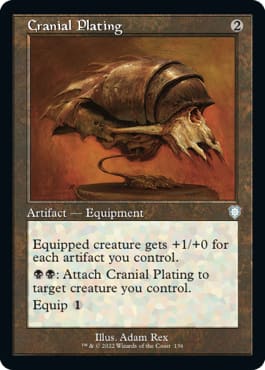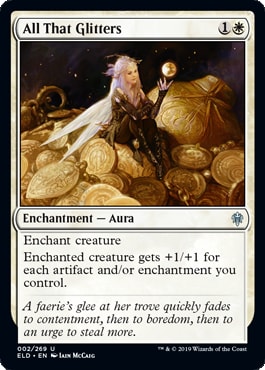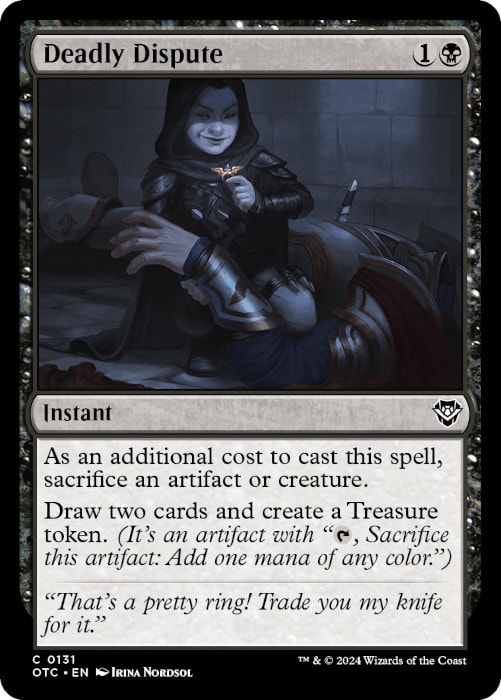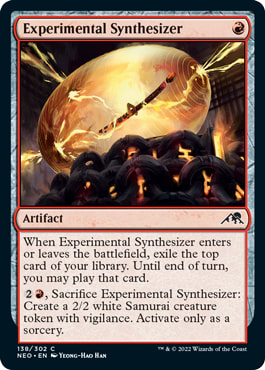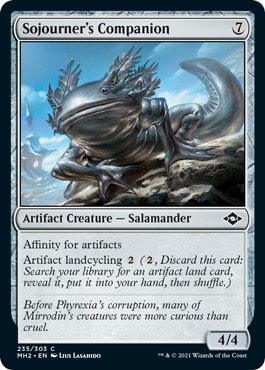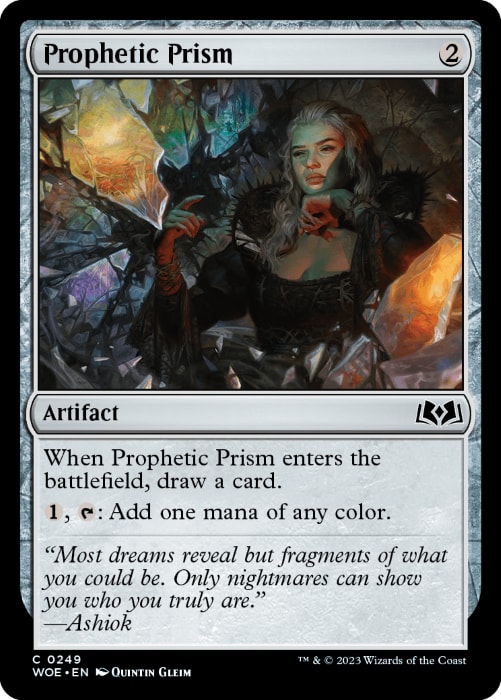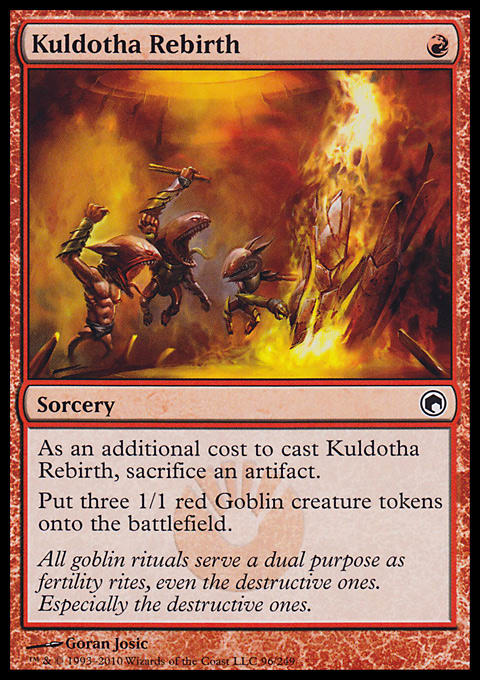Last week, Gavin Verhey on behalf of the Pauper Format Panel announced something rather unprecedented: Cranial Ram was being preemptively banned in Pauper.
This card bears striking resemblances to the cards Cranial Plating and All That Glitters, which are both banned already. Reasons for this decision include the aforementioned similarities, ease of slotting into existing decks, and the fact that these decks would undoubtedly dominate two major upcoming Pauper events. Rather than risk Pauper's version of PT Hogaak, PT Simic Oko, or Eldrazi Winter, the Pauper Format Panel decided to take early action against this powerful card.
This has led to some comments and concerns from among the community, continuing to voice the same discussion that the format has seen for some time. If these artifact-reliant payoffs are constantly being banned, why not deal with the artifact lands that enable them? After all, there are no less than six cards banned due to their usage in Affinity lists (Cranial Plating, Sojourner's Companion, Atog, Disciple of the Vault, All That Glitters, and now Cranial Ram). With so many cards, why not just touch the lands instead?
Today, I'd like to do a bit of a deep dive and provide a rather in-depth examination of the artifact lands, their place in Pauper, and whether the format could allow the previously banned cards without them. This is going to be a lot more intricate of an analysis compared to what I normally publish, so I hope it can provide you with a better understanding of these cards' place in the format.
Before we go any further, I want to make something explicitly clear, as I myself am a member of the Pauper Format Panel: the views in this article are my own and do not necessarily reflect those held by the entire PFP. There are members in the PFP who may not necessarily share the same thoughts and perspectives I'm presenting here. Rather, this is showing how I view the situation and am providing analysis from that singular viewpoint. This is just one side of the discussion (my side) and it is a constantly ongoing discussion within the PFP itself. As such, this piece should not be taken as a direct indication of what will or will not happen in future bans.
With that out of the way, let's start from the top with the obvious: what are the artifact lands and why are they so impactful? If you're a seasoned Pauper player, or even a longtime Magic player in general, this topic may be somewhat old hat for you. However, there are likely to be many people who don't quite understand what all the hubbub is about when it comes to this set of lands.

The original five artifact lands were released in Mirrodin with one fore each color, as well as an additional colorless one showing up in the following set Darksteel featuring indestructibility. These lands completely broke the Standard environment they were in when paired with the "affinity for artifacts" mechanic used on cards like Frogmite, Myr Enforcer, and Thoughtcast. Because of these tremendous synergies, all six artifact lands were banned alongside the cards Arcbound Ravager and Disciple of the Vault (as well as Skullclamp for its own reasons).
The artifact lands were deemed mistakes and were not only banned in Standard, but also in Extended, Mirrodin Block Constructed, and eventually Modern. Only three competitive settings remained where you could play them actively: Legacy, Vintage, and Pauper. While classic Affinity lists eventually fell off in Legacy and was never really a thing in Vintage, it remained an all-star in Pauper. The deck was the reason we saw the first official ban for the format in Cranial Plating when it became an officially recognized format on Magic Online and was one of the few archetypes that could hold its own in the original Grapeshot Storm era.
As time went on and other decks saw their cards get banned, Affinity continued to stick around as a strong yet manageable player in the format. This was in no small part due to the fact that you could tear apart the deck's mana base with cards like Gorilla Shaman and Gleeful Sabotage, slowing the deck down enough to allow smaller decks to deal with it. Additionally, the deck could also struggle with mana, as most Affinity builds of the era were three colors and didn't have great fixing with only Chromatic Star/Sphere and Prophetic Prism to smooth things out.

Then Modern Horizons 2 came out in 2021 and everything changed. We got a set of ten all new artifact lands at common. These were dual lands, and more importantly, they were indestructible, which meant you couldn't blow them up the way you traditionally could with the original ones. This gave a lot more potency to the existing decks as it became harder to disrupt Affinity, especially since the set also brought Myr Enforcers 5-8 in the form of Sojourner's Companion. Because of that, many players feel these cards are the reasons Affinity has gotten to be too strong and has seen numerous bans over the past couple years.
I don't think this is an accurate picture at all, though. To many, it's easy to draw the line in the sand at Modern Horizons 2 because that's where it got much more buffed up. In reality, though, the power kept coming through with the sets that followed it. Barely a month after Modern Horizons 2 released, Dungeons & Dragons: Adventures in the Forgotten Realms released and with it came the printing of Deadly Dispute. This card was a variant of Costly Plunder that gave you a little more than just two cards for sacrificing an artifact or creature. When paired with something like Ichor Wellspring or Chromatic Star, it often feels like an Ancestral Recall as it draws you three cards and leaves you with an extra mana behind in the treasure. Oh, and that treasure helps your affinity count as well.
This was just the start of powerful enablers and high impact cards. Here's a handful more that came out in the months that followed that made Affinity decks that much stronger:
- Blood Fountain in Innistrad: Crimson Vow. Provided two artifacts for 1 mana and allowed you to return creatures from your graveyard to your hand.
- Wedding Invitation in Innistrad: Crimson Vow. A cheap artifact that cantrips and enables you to push damage through.
- Voldaren Epicure in Innistrad: Crimson Vow. A cheap creature that spits out an artifact. Not as potent and saw almost no play in Affinity, but is yet another cheap artifact enabler that would push other artifact decks like Kuldotha Red. With less powerful artifact generators, this would likely be played more in Affinity.
- Experimental Synthesizer in Kamigawa: Neon Dynasty. Enables cheap deck churn while providing you additional artifacts and sacrifice fodder for Deadly Dispute (and the next card)
- Reckoner's Bargain in Kamigawa: Neon Dynasty. Another Costly Plunder variant, this is not as good as Deadly Dispute, but the life gain proves highly relevant - especially when sacrificing a Myr Enforcer.
This is only a small sampling of just how much the card pool of artifact enablers ballooned in such a short time frame. Other powerful additions include Kenku Artificer, Tithing Blade, the downshifting of Makeshift Munitions, the functional reprint of Thraben Inspector in the form of Novice Inspector, and more smaller inclusions. Some even showed up for a while and then fell off in favor of better newer toys, like how Gixian Infiltrator was utilized for a hot minute and considered by some at the time to be even better than Atog. Oh, and this doesn't include the cards that got banned (All That Glitters and Cranial Ram) nor upcoming cards in Modern Horizons 3 like Refurbished Familiar.
All of this is to say that to put all the blame squarely on the shoulders of the bridges doesn't quite tell the whole story or paint a complete picture. Yes it's an important facet and if certainly pushed Affinity to new heights, but it's not quite as glaringly "this is all the fault of the bridges." That gets even more true when you look at the cards banned from Affinity and the reasoning for their bans. Let's have a look at each card individually and break down why they were banned.
Simply put: eight copies of Myr Enforcer is probably more than a format like Pauper can bear, and this is the stronger of the two thanks to the landcycling. It's simple, but remarkably dangerous even if you remove a single cycle of artifact lands from the format.
Oh yeah, everyone's favorite smiling artifact muncher. More than any card hit from Affinity, players tend to put the blame squarely on the bridges for the banning of Atog. The logic tends to go that Atog was fine prior to the printing of the bridges, so why ban it now when you could just, you know... ban the bridges? The reality is that Atog was always sort of on the cusp of eating a ban. Remember where way earlier in this article I noted that Affinity could hang with the likes of Grapeshot Storm and Invigorate Infect? Yeah, Atog was a big reason as to why, and the out of nowhere kills were always a problematic play pattern.
The bridges definitely made it more powerful, but what really pushed it were all those other enablers. If you play a Deadly Dispute you draw more fuel for your Atog to kill quicker and still leave an artifact behind. Blood Fountain provides two artifacts for the Atog to eat as compared to the usual one. Experimental Synthesizer just showers you in value for sacrificing it to the big smiley boy. Even Wedding Invitation was used as a means to push damage through via attacking rather than utilizing the usual copies of Fling and Temur Battle Rage.
In short: the addition of the bridges helped push Atog, but what really made it that much more egregious was the other cards that came out soon after. The card was always teetering on being a real problem and this deluge of cards just pushed it. It's worth noting as well that at the time Atog was banned, Rakdos was the most popular build of Affinity. As such, banning the bridges likely wouldn't have left much of an impact and would've instead pushed out Grixis due to the simultaneous banning of Prophetic Prism (more on that in a moment). The deck would've simply adapted to running a few less artifact duals and utilized other lands instead with largely the same endgame. You'll hear this sort of thing a lot going forward here.
This ban was actually more for handling Tron and came alongside Bonder's Ornament. It did, however, impact Affinity that much more. While numerous people were against it then, and there has been some debate among the Pauper Format Panel about bringing it back, there's concern that it could just push Affinity to be better and more consistent in its mana once again.
Disciple is an odd one because for a long time it didn't see much play in Affinity lists and was considered bad despite the comparisons to original Mirrodin block's powerful Raffinity deck. With the bridges, easily sacrificed artifact tokens in Blood and the like, Deadly Dispute and its ilk, and so on, it became far more potent of a card. It almost went alongside Atog, but the Panel determined that it was better to see if it would be a problem even without Atog. Turns out that it was, and so it too was banned. Once again, while the bridges were a player here, the real key was all the other things that you could now easily sacrifice and ways by which you could do the sacrificing, like with Makeshift Munitions.
I'm going to talk about these together because they're pretty darn comparable. Both cards enable explosive finishes with tremendous power swings that can kill practically out of nowhere. A lot of concern was pointed once again in the direction of the bridges but if you looked at the majority of the decks playing All That Glitters, the biggest players were usually two color decks. Yes, there was a Jeskai Affinity version that was the best for a moment until Murders at Karlov Manor brought Novice Inspector, but two of the three main versions were Azorius Affinity and Boros Synth. This goes back to what I mentioned with Atog: you could ban the bridges, but then you're only removing four artifact lands and the deck is still left with 8-12, and adjusts smoothly.
This was expected to be a similar instance with Cranial Ram. Two versions of Affinity likely run it best: the pre-existing Grixis Affinity and a new Rakdos Affinity build that would almost certainly show up as well. Should you remove the bridges, the deck simply turns fully into Rakdos Affinity and only loses a few lands in the process. The bridges are then either replaced with basics, non-artifact dual lands, or even an off-color artifact land that's simply treated as a colorless land for all intents and purposes. After all, even Temur Affinity did this pre-MH2 when it would sometimes play a one-of Vault of Whispers or Ancient Den just for a 17th land.
If you're having trouble visualizing this, let me show you an example I've had lying around for several months now. This is an Azorius Affinity list you might've seen prior to the banning of All That Glitters:
Azorius Affinity | Pauper
- Creatures (24)
- 4 Gingerbrute
- 4 Moon-Circuit Hacker
- 4 Myr Enforcer
- 4 Novice Inspector
- 4 Ornithopter
- 4 Thraben Inspector
- Instants (4)
- 4 Metallic Rebuke
- Sorceries (7)
- 3 Of One Mind
- 4 Thoughtcast
- Enchantments (4)
- 4 All That Glitters
- Artifacts (4)
- 4 Springleaf Drum
- Lands (17)
- 1 Island
- 2 Plains
- 2 Darksteel Citadel
- 4 Ancient Den
- 4 Razortide Bridge
- 4 Seat of the Synod
- Sideboard (15)
- 2 Blue Elemental Blast
- 2 Hydroblast
- 2 Relic of Progenitus
- 2 Standard Bearer
- 3 Turn Aside
- 4 Dust to Dust
I played a list just like this for a bit while it was legal, as it felt like the closest experience I'd had toward classic Standard/Modern/Legacy Affinity builds in some time. It was an extremely powerful deck and it wasn't a stretch to have games where you stick the landing on a turn two Gingerbrute suited up with an All That Glitters. You could even get that Gingerbrute to an 8/8 that early, and make it unblockable!
Now let's look at how this list might look if the bridges were banned in the format:
Azorius Affinity (No Bridges) | Pauper
- Creatures (24)
- 4 Gingerbrute
- 4 Moon-Circuit Hacker
- 4 Myr Enforcer
- 4 Novice Inspector
- 4 Ornithopter
- 4 Thraben Inspector
- Instants (4)
- 4 Metallic Rebuke
- Sorceries (7)
- 3 Of One Mind
- 4 Thoughtcast
- Enchantments (4)
- 4 All That Glitters
- Artifacts (4)
- 4 Springleaf Drum
- Lands (17)
- 2 Island
- 2 Plains
- 1 Tranquil Cove
- 4 Darksteel Citadel
- 4 Ancient Den
- 4 Seat of the Synod
- Sideboard (15)
- 2 Blue Elemental Blast
- 2 Hydroblast
- 2 Relic of Progenitus
- 2 Standard Bearer
- 3 Turn Aside
- 4 Dust to Dust
With this, you're essentially substituting four artifact dual lands for two colorless artifact lands, a non-artifact dual, and a basic land. This is not how a serious competitive list would actually look, but rather it provides a solid exploration into how easy it is to adjust the list without making many changes. Instead of the extra basic, you could put in another Tranquil Cove. You could even just add in one Darksteel Citadel instead of two. Some elements of the non-land build may have to shift slightly to accommodate the changes in mana base.
At its core, though, you're still left with the brutally powerful kill shot that All That Glitters causes when it's allowed in the format. These same principles could then be applied to the Boros Synth lists which likely just switch over to non-artifact duals like they used to run and you still get those same All That Glitters finishes. With Cranial Ram, the same thing then happens when your deck slims down into a Rakdos form. It simply sheds the bridges and continues with an extremely powerful strategy that can wipe out a number of decks with ease. It also goes back to the same kinds of arguments with Atog and Disciple of the Vault in their respective Rakdos builds as well.
This makes it really hard to touch any of these cards and remove them from the ban list even if you do ban the bridges. As such, is it worth it to ban the bridges if nothing can come off? You future proof some elements, but you also change the texture of the wider format as well. Affinity isn't the only archetype playing them, after all. Decks like Goblin Combo, non-Glitters builds of Boros Synth, and even Jeskai Ephemerate with its much memed Cleansing Wildfire interaction would all be impacted by this banning. Is that worth it?
This then leads to looking at the opposite side of the spectrum. What happens if you ban the original Mirrodin lands? Do things improve much? Well, probably not as much as players might think. In the case of All That Glitters, decks likely lean more into the Jeskai builds and possibly even skew a bit towards something like Mardu. With Cranial Ram, you also stay the course with Grixis and, again, maybe something Mardu-esque. In each situation, your deck is likely a bit slower, but makes up for it by utilizing basic lands to fill in gaps with untapped lands or just uses Darksteel Citadel provided that isn't banned with the colored lands of Mirrodin proper. In these situations, cards like Atog and Disciple of the Vault also likely end up being too strong.
This causes a dilemma. Players love the original Mirrodin lands as they feel they've become a core element of Pauper's identity. Much like how removing the bridges would impact several decks, the Mirrodin lands would have a similar and even potentially larger impact. This too would impact the likes of Goblin Combo and Boros Synth but it also brings down the power level of Kuldotha Red by quite a bit as well. Players like doing these crazy things and removing these lands could bring the power down so much it kills them, as you're often losing 8+ lands vs. the four-ish you'd lose by axing the bridges. The panel even polled various places - primarily Twitter - for feedback and a major sticking point was players not wanting these Mirrodin lands banned because of their iconic status.
So, then what do you do? Do you ban just one cycle of the bridges or the Mirrodin lands, even if you're likely unable to unban anything? Do you ban all of them in the hopes that you can bring something back? You'd end up largely upending a massive chunk of the format in the process if you were to do that, which would completely change the way the format exists. It's even more important to note too that several other powerful decks like Tolarian Terror, Faeries, Caw Gates, Familiars, and Golgari Gardens wouldn't be impacted by such a move, which heavily pushes things in favor of those kinds of decks instead.
This is the problem that comes with the artifact lands in general. The reason they come up so often in the format updates provided by the Pauper Format Panel is that simply put, they're problematic enough that it's worth exploring whether they should be touched or not. It's not just a surface level examination that's done either, but rather in-depth looks. If bans happen, how does it affect things? How do decks and the format adjust? Is it likely that further bans will have to happen due to the power vacuum? Would players enjoy the format they're left with? All of these and more are taken into account and factored in when making a decision.
I hope that this provides you with some deeper insight with regards to these artifact lands and their relationship with the greater Pauper format as a whole. I think given the circumstances, it's likely you'll see them come up in future discussions surrounding the format, whether action is taken or not. So, given all of this: what do you think should be done going forward, if anything at all?
Paige Smith
Twitter: @TheMaverickGal
Twitch: twitch.tv/themaverickgirl
YouTube: TheMaverickGal
















